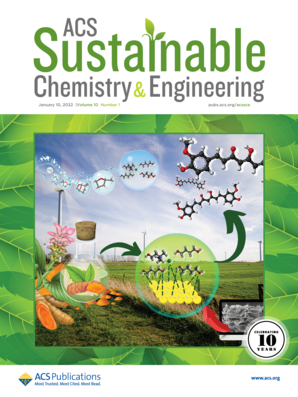与生物糖生产预处理技术相关的温室气体排放
IF 7.1
1区 化学
Q1 CHEMISTRY, MULTIDISCIPLINARY
引用次数: 0
摘要
从木质纤维素材料中生产低碳密集型生物糖可以改善生物燃料和生物产品的制造。在本研究中,分析了生物糖的生产,以了解从生物糖生产低碳强度生物制品的潜力。对五种木质纤维素原料以及七种预处理技术进行生命周期评估,以生产生物糖作为生产生物产品的重要平台中间体。利用木质素生产电力,有或没有热集成也被纳入。此外,对7种生物制品进行了分析,以估算温室气体排放预算,这代表了在70%减排目标内将生物糖转化、分离和升级为生物制品的排放量。玉米秸秆脱乙酰和稀酸预处理(CS-DDA)对生物糖的温室气体排放量最低(0.03 kg CO2当量/kg生物糖),因此对乳酸生产的温室气体排放预算最高(3.76 kg CO2当量/kg乳酸)。天然气和化学品是所有正在研究的预处理技术的主要贡献者。这项研究的结果可以促进即将到来的满足脱碳目标的生物基工艺的发展。本文章由计算机程序翻译,如有差异,请以英文原文为准。

Greenhouse Gas Emissions Associated with Pretreatment Techniques Utilized for Biosugar Production
Less carbon-intensive production of biosugars from lignocellulosic materials can lead to improved manufacturing of biofuels and bioproducts. In this study, the production of biosugars is analyzed to understand the potential of producing bioproducts from biosugars with a low carbon intensity. Life-cycle assessment is conducted on five lignocellulosic feedstocks along with seven pretreatment techniques to produce biosugars as an important platform intermediate for producing bioproducts. The production of electricity using lignin with and without heat integration was also incorporated. In addition, seven bioproducts are analyzed for the estimation of the GHG emissions budget, which represents the emissions available to convert, separate, and upgrade biosugars into bioproducts within the 70% emissions reduction target. Corn stover-deacetylation and dilute acid pretreatment (CS-DDA) provide the lowest GHG emissions for biosugar (0.03 kg CO2 eq/kg biosugar) and thereby the highest GHG emissions budget for the case of lactic acid production (3.76 kg CO2 eq/kg lactic acid). Natural gas and chemicals are the major contributors to all of the pretreatment techniques under study. The outcomes from this study can benefit the advancement of upcoming biobased processes that meet decarbonization targets.
求助全文
通过发布文献求助,成功后即可免费获取论文全文。
去求助
来源期刊

ACS Sustainable Chemistry & Engineering
CHEMISTRY, MULTIDISCIPLINARY-ENGINEERING, CHEMICAL
CiteScore
13.80
自引率
4.80%
发文量
1470
审稿时长
1.7 months
期刊介绍:
ACS Sustainable Chemistry & Engineering is a prestigious weekly peer-reviewed scientific journal published by the American Chemical Society. Dedicated to advancing the principles of green chemistry and green engineering, it covers a wide array of research topics including green chemistry, green engineering, biomass, alternative energy, and life cycle assessment.
The journal welcomes submissions in various formats, including Letters, Articles, Features, and Perspectives (Reviews), that address the challenges of sustainability in the chemical enterprise and contribute to the advancement of sustainable practices. Join us in shaping the future of sustainable chemistry and engineering.
 求助内容:
求助内容: 应助结果提醒方式:
应助结果提醒方式:


